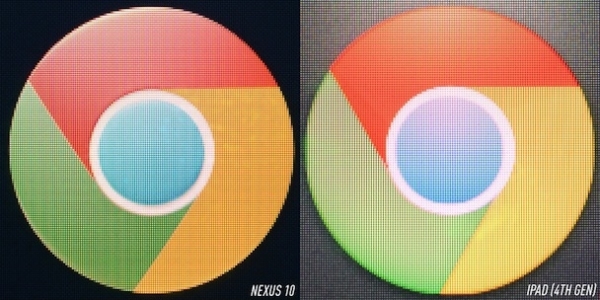Retina and other ultra-high resolution displays

With the introduction of iPad mini 2 with Retina display, Apple made another revolution. The screen resolution is 2048x1536 pixels, which was then much higher than the monitors and laptops of the vast majority of users.
At the time of its introduction, Retina screens were considered the most progressive. Implemented on IPS technology, they were distinguished not only by high resolution, but also by excellent indicators of brightness and contrast, good viewing angles vertically and horizontally. Prior to this, only people using expensive Hi-End monitors could work with such a high-quality image.
With a similar step, Apple, in fact, s initiated a new race among portable device manufacturers — the race for high resolutions.
b>
Smartphones with high screen resolution
Long time resolution screens of most mobile devices was 240x320 pixels, which was quite enough to solve the problems that users face. With the development of technology and the increase in the range of use, it became obvious that the resolution needed to be increased.
.jpg) |
| Samsung Galaxy Note 4 and Galaxy Note Edge, both smartphones boast ultraHD 2K resolution |
The increase in the display had a corresponding effect on the resolution, which is quite logical. The vast majority of popular smartphones have resolution 1280x720 (HD). 800x480 is already considered the lower acceptable threshold for a modern smartphone, and anything less is hardly comfortable to use.
Not so long ago, Apple introduced the long-awaited sixth version of their smartphone. As expected, the trend towards larger screens did not bypass them either, Apple iPhone 6 Plus has a 5.5-inch screen with FullHD resolution and a density of 401 ppi. But in the meantime, competitors have already launched the first smartphones with resolution ultraHD 2K and a density greater than 500 ppi.
Ultra-high-resolution tablet screens
The next logical step was the introduction of Retina to the iPad. Although the implementation of this project required the solution of some specific tasks, Apple successfully coped with them and already the third generation of the tablet computer has acquired ultra-high resolution screens. iPad 3 (The new iPad) is 2048×1536 pixels — four times larger than the iPad 2. Subsequently, the same screen was used in iPad 4 (iPad with Retina). But the first generation iPad mini did without Retina. For several reasons, the main of which is the desire to reduce the cost of the model.
But one should not think that mobile devices with high-resolution screens are produced exclusively by Apple. In fact, the advent of Retina unleashed the race. Similar solutions began to appear in other manufacturers seeking to attract the attention of consumers to their products. So devices like Google Nexus 10 16GB were released with a resolution of 2560x1600 pixels.
 | |
| Image quality comparison between Google Nexus 10 and < a href="/APPLE-IPAD-4-16GB--WITH-RETINA-.htm">Apple iPad 4 at multiple zoom |
 |
| Laptop rating — last month source E -catalog |
The advent of Retina in laptops has greatly improved the quality of the image on the screen. However, such a significant increase in resolution required software optimization. After all, programs that were perfect for familiar resolutions look unpleasantly blurry on Retina screens. This process is relatively slow — the popular Microsoft Office and Adobe Creative Suite packages were adapted only after 4-5 months after the first MacBook Pro Retina appeared. However, all new software for OS X is now being created taking into account the high resolutions.
However, the appearance of Retina in computers requires adaptation not only of software, but also of websites. Even the most beautiful resource will not look the best without the use of high-resolution images. And this process, unlike software development, can take much more time. Websites have always lagged somewhat behind the development of technology. By the way, shortly before the appearance of the first laptops with Retina, the creator of the Linux operating system Linus Torvalds published his thoughts, in which he complained that the resolution of modern laptops had stopped in its development and was not increasing.
< p> As for other developers, laptops with resolution 2560x1440, 2880x1620 and even 3200x1800. At the time of writing, there were not so many of them yet, but I would like to believe that others will actively follow the example of Apple. And that over time, ultra-high resolutions will become commonplace, and not be used exclusively in expensive devices.What is Ultra HD? Should I buy ultra-high definition TVs?
If you need an inexpensive smartphone that meets modern ideas about functionality.
What is NFC technology used for, scenarios for its use in smartphones and other devices.
Discrete graphics model, convertible and laptop/tablet hybrid on a low-cost.
Which mid-range TVs should you pay close attention to.
Articles, reviews, useful tips
All materials





Sound & Hi-Fi 47
Climate, Heating, Water Heating 82
Large Appliances 107
Small Appliances 96
Mobile Phones & Gadgets 136
TVs & Video 39
Kids & Toys 29
Computing 240
Monitors 31
Desktop PCs 54
Laptop Batteries 2
Laptop Bags 5
Laptops 71
Laptop Chargers 3
Laptop Coolers 4
Laptop Parts 2
Other for Laptops 2
SSD 37
CPUs 28
Motherboards 32
RAM 28
Graphics Cards 40
Hard Drives 8
Sound Cards 1
Computer Cases 33
Thermal Pastes & Thermal Pads 3
Computer Cooling 24
PSUs 23
Drive Cases & Docks 3
Switches 1
Wi-Fi Equipment 22
NAS Servers 1
Routers & Firewalls 4
Network Cards 1
Antennas for Routers 5
Ethernet Cables 1
Powerline Adapters 1
PC Speakers 4
Webcams 3
Card Readers & USB Hubs 6
VR Headsets 2
Gaming Consoles 14
Games 1
Console Accessories 1
Keyboards 21
Game Controllers 8
Mice 17
Mouse Pads 3
E-Readers 3
E-Readers Cases 1
Tablets 30
Tablet Cases 1
Tablet Screen Protectors 1
Stylus Pens 1
Photo 47
Office & Stationery 4
Camping & Fishing 39
Tools & Gardening 90
Sports & Outdoor 32
Watches, Jewelry & Accessories 9
Home & Renovation 72
Cosmetics & Fragrances 2










